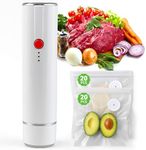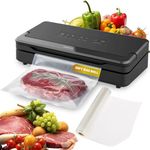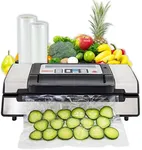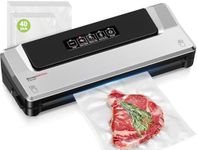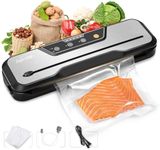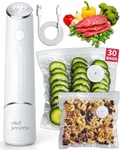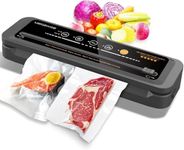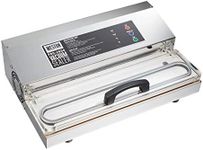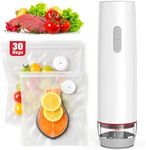Buying Guide for the Best Vacuum Sealers
Choosing the right vacuum sealer can make food storage easier, help reduce waste, and even save you money in the long run. The best vacuum sealer for you depends on how often you plan to use it, what types of food you want to seal, and how much space you have in your kitchen. Understanding the key features will help you find a model that fits your needs and makes the process of sealing food both efficient and convenient.Type (External vs. Chamber)The type of vacuum sealer refers to how the machine removes air from the bag. External (or edge) sealers are the most common for home use and work by placing the open end of a special bag into the machine, which then sucks out the air and seals it. Chamber sealers, on the other hand, place the entire bag inside a chamber and remove air from both the bag and the chamber. Chamber sealers are more powerful and can handle liquids better, but they are larger and more expensive. If you mostly seal dry foods or use the sealer occasionally, an external model is usually sufficient. If you plan to seal soups, stews, or do a lot of bulk sealing, a chamber sealer might be worth considering.
Seal WidthSeal width is the length of the sealing bar, which determines how wide a bag you can seal. Common widths range from about 8 to 15 inches. A wider seal bar allows you to use larger bags, which is useful for sealing big cuts of meat or bulk items. If you mostly seal small portions, a standard width is fine, but if you want flexibility for larger items, look for a wider seal bar.
Suction PowerSuction power, often measured in inches of mercury (inHg) or kilopascals (kPa), indicates how strongly the machine can remove air from the bag. Higher suction power means a tighter seal and better preservation, especially for long-term storage. For most home uses, moderate suction is enough, but if you want to store food for months or seal items with sharp edges, higher suction power is beneficial.
Bag CompatibilityBag compatibility refers to the types and sizes of bags the sealer can use. Some machines only work with proprietary bags, while others can use generic or even rolls that you cut to size. If you want to save money or have more flexibility, look for a model that works with a variety of bags and rolls. If convenience is more important, proprietary bags might be easier to use.
Wet/Dry ModesWet/dry modes allow the vacuum sealer to adjust its sealing process depending on whether you are sealing dry foods or items with moisture. Wet mode helps prevent liquids from being sucked into the machine, which can damage it or weaken the seal. If you plan to seal marinated meats, cooked foods, or anything with liquid, having a wet mode is very helpful. For mostly dry foods, this feature is less critical.
Manual vs. Automatic OperationSome vacuum sealers are fully automatic, starting the vacuum and sealing process with the push of a button, while others require you to manually control the process. Automatic models are easier and faster to use, making them great for frequent use or beginners. Manual models give you more control, which can be useful for delicate foods that might get crushed. Think about whether you prefer convenience or control when choosing between these options.
Size and StorageThe size of the vacuum sealer affects how much counter or storage space it will take up in your kitchen. Larger models may offer more features or power, but they can be bulky. If you have limited space, look for a compact model that is easy to store. If you plan to use it often and have the space, a larger model might be more convenient.
